In ancient cultures, most practitioners of supernatural skills were men. They were the religious officials of various pagan cults, who were considered ritual specialists in the magical arts. It wasn’t until later, during medieval times, that a witch was considered a person who performed harmful supernatural acts against others. And, the introduction of demonic forces into empowering their art (wrongdoing causing harm, injury, or loss to another party), occurred mostly after the 15th century.1
Witches in pre-Christian times mostly practiced the arts of divination, which included various types and subcategories. Witches (mediums/sorcerers) consulted beings (spiritual entities; departed humans), or observed omens (by studying objects or actions), all to gain information about the future, or discern matters not of common knowledge.2
Witchcraft is a fascinating study, but one that is rather involved and complicated, so the above descriptions are but a slight overview for the purpose of this article. There are many scholarly books available for those who are interested. The Holy Bible, too, has much to say about witchcraft, but the practice gets no approval from God. Why?
The Bible instructs us not to use the supernatural arts; however it doesn’t say they don’t work. But, there is a major difference between having a spiritual experience with God through prayer and having one with other spirits (Satan, fallen angels, demons) through witchcraft. Communicating with God helps Christians learn and do what is necessary to gain salvation to eternal life, whereas using witchcraft requires forsaking God and worshiping the devil, which buys you a ticket to eternal destruction. Another difference is this — with God, he chooses you, but with the devil, you choose him. It’s all about choices, folks!
 This world consists of not just what we see; there are real spirits among us, as warned by the apostle Paul. He wrote, “our struggle is not against enemies of blood and flesh, but against the rulers, against the authorities, against the cosmic powers of this present darkness, against the spiritual forces of evil in the heavenly places, (Ephesians 6:12). See the article “Ephesians 6:12: Satan, Fallen Angels, & Demons — the Real Enemies of Our Faith” listed in References & Notes.3
This world consists of not just what we see; there are real spirits among us, as warned by the apostle Paul. He wrote, “our struggle is not against enemies of blood and flesh, but against the rulers, against the authorities, against the cosmic powers of this present darkness, against the spiritual forces of evil in the heavenly places, (Ephesians 6:12). See the article “Ephesians 6:12: Satan, Fallen Angels, & Demons — the Real Enemies of Our Faith” listed in References & Notes.3
One author explained it this way. “There are a few today who would deny that the cosmos is throbbing with life. And who would limit life to that which is seen? Neither Judaism nor Christianity deny the existence of spirits. King Saul consulted the witch of Endor who evoked the spirit of Samuel for him, although necromancy and witchcraft were forbidden. . . . There may be demons and angels, good and bad spirits, but they exist in a realm extraneous to ours, with which man should not tamper.”4
Those who desire to consort with evil spirits are not motivated by love as revealed through God, but by reasons contrary to God’s will. In opposition to some popular beliefs, you cannot practice witchcraft and still lead a godly life. That was King Saul’s error in consulting with the Witch5 of Endor,6 which is the subject of our study.
Saul becomes King
Our story begins during the time of Samuel, Israel’s last judge. The nation was divided, each of its twelve tribes demonstrated fierce loyalties within their own clans and their anger was against each other, sometimes almost as much as their foreign enemies. And their enemies were many, but none worse than the Philistines. Complaining to Samuel, they said there was no hope of survival, unless they had a real king to organize and lead them — they wanted what other nations had.7
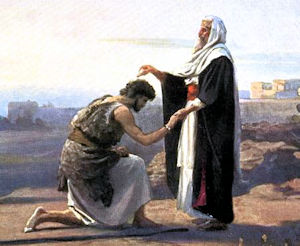 Samuel was guided by the Lord to anoint Saul, the tallest and most handsome man in Israel. Saul was acclaimed as king after he had proven himself in battle.8 He was from the tribe of Benjamin, and was humble in the beginning of his reign, but soon became very proud and was disobedient to God’s instructions.
Samuel was guided by the Lord to anoint Saul, the tallest and most handsome man in Israel. Saul was acclaimed as king after he had proven himself in battle.8 He was from the tribe of Benjamin, and was humble in the beginning of his reign, but soon became very proud and was disobedient to God’s instructions.
On several occasions, Saul refused to obey God and even performed other acts in a self-righteous manner. Finally, our Lord sent Samuel to tell him that God has rejected him as king and was going to select another man to take his place. This confrontation did not go smoothly. Regular meetings of these two men end and, in due time, Samuel dies.
Saul also had mood swings and began to be tormented with fits of madness. So David, a young shepherd man of amazing courage and a skilled musician, is sent to soothe the king with his music and give needed military advice. This is the man who won victory over the giant Goliath9 (of whom Saul was fearful) and became very popular through continued victory over the king’s enemies, so popular in fact, that Saul viewed him as a rival to the throne.10 Saul begins to plot David’s death, and his persistence increases until David flees to the Philistines (the enemy), leaving King Saul to fight his battles alone.
The Witch of Endor
The story concerning the ‘Witch of Endor’ is told in the First Book of Samuel, chapter 28. There are only twenty-five verses, so you should read them, if you can. The beginning of the chapter reestablishes some facts: the prophet Samuel is dead, the Philistines are positioning themselves for battle against King Saul, David has moved his allegiance to the Philistine side, and it is mentioned that Saul had previously eradicated the mediums and necromancers from of the land.
Now a ‘medium’ is a person thought to have the power to communicate with the spirits of the dead,11 while ‘necromancy’ is the actual act of conjuring up the dead spirits to predict or influence future events.12 Now, the law of Moses prohibited consulting with practitioners of the supernatural arts (Leviticus 19:31; 20:27; Deuteronomy 18:10–11), so Saul’s effort to rid the land of them was commendable.13
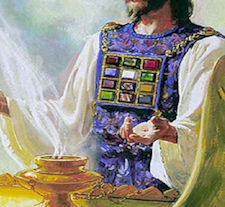 However, without Samuel for advice or David for military help, Saul finds himself alone to fight his enemies. His kingship has been a disaster and is even worse, now. He calls upon God for help, but does not get an answer. What does he do?
However, without Samuel for advice or David for military help, Saul finds himself alone to fight his enemies. His kingship has been a disaster and is even worse, now. He calls upon God for help, but does not get an answer. What does he do?
When Saul inquired of the LORD, the LORD did not answer him, not by dreams, or by Urim, or by prophets. Then Saul said to his servants, “Seek out for me a woman who is a medium, so that I may go to her and inquire of her.” His servants said to him, “There is a medium at Endor.” (1 Samuel 28:6-7, NRSV).14
The Urim mentioned was a stone placed in the Breastplate of the high priest, which he wore when he went into the presence of the Lord to ascertain the will of God.15 So, since God didn’t answer and the high priest couldn’t help, he took matters into his own hands. Although he had previously rid the country of pagan witches (1 Samuel 28:3), he decides to visit one himself, hoping to speak with the dead prophet Samuel. It is amazing what some will do, when frightened enough, and once again, Saul went against God’s laws.
Since Saul had eradicated the supernatural pagan cults and their professionals from the land, he was forced to find a secret practitioner among the women. Even before being banned, most women were not allowed to officiate within the pagan cults. So, many women with such skills set up little-advertised businesses away from the temples — private practices, so to speak.16 When Saul inquired of such a person, he used the specific phrase meaning someone proficient in necromancy. So, Saul disguises himself, takes a couple of companions, and off to see the witch, they go.
Upon meeting the medium, she asks, “Whom shall I bring up for you?” He answered, “Bring up Samuel for me,” (1 Samuel 28:11). The woman begins to establish contact and screams when she suddenly sees an image.
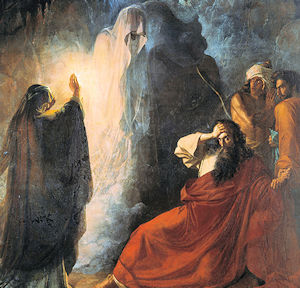 Being surprised, possibly, was an indication that it was God who brought about the appearance — not the witch.17 She also recognized Saul. “Perhaps the woman recognized Saul in the light of Samuel’s appearance, or perhaps the king pulled back his hood . . . ” looking around for the image that the witch saw.18
Being surprised, possibly, was an indication that it was God who brought about the appearance — not the witch.17 She also recognized Saul. “Perhaps the woman recognized Saul in the light of Samuel’s appearance, or perhaps the king pulled back his hood . . . ” looking around for the image that the witch saw.18
This spirit rebukes Saul by telling him he did not obey God and did not carry out his instructions. Because of this, Saul’s kingdom has been taken away and given to another man. Furthermore, Saul and his sons will be given into the hands of the Philistines and will die (see 1 Samuel 28:15-19).
Did the witch really conjure up the dead Samuel? Though some scholars disagree on the answer to this question, many believe she did, suggesting as we have already said, the Mosaic Law sternly forbids consultation of mediums, but it does not say that communicating with spirits is impossible.19 Obviously something happened and it got recorded in the Bible, but scripture lays down the facts of events, but not always the various details. Let us examine this event and suggest some possibilities.
What really happened?
Scripture, such as that found in the Book of Ecclesiastes, suggests this event should be impossible: “The living know that they will die, but the dead know nothing,” (Ecclesiastes 9:5a). But, scripture also says that death is resting in sleep until a later time of resurrection. “Many of those who sleep in the dust of the earth shall awake, some to everlasting life, and some to shame and everlasting contempt,” (Daniel 12:2). Some commentators, therefore, suggest that God woke Samuel from his sleep, to communicate with Saul.
And, there are two other interesting points that slip past the reader of this narrative. “The woman had seen an image but not heard his words; Saul had heard the words but not seen the apparition (1 Samuel 28:13–14).”20 So, commentators disagree as to what actually happened. Some feel that it was an evil spirit that impersonated Samuel, while others believe that God interrupted the seance unexpectedly by allowing the real Samuel to appear.21
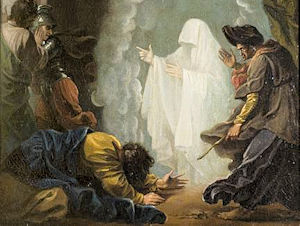 Although nothing is impossible for God (Luke 1:37), I don’t think he would help Saul in accomplishing an act using techniques that God, himself, thought as abominable. I am of the opinion that it was not Samuel, but not an evil spirit, either. I believe this situation was controlled by God or an angel of God. Remember that the witch cried out in surprise, which meant she wasn’t in control. Another commentator agrees that the witch didn’t have command of the situation,22 and yet another that it must have been a work of God.23 Other observations are that the witch of Endor described the apparition as a divine being, elohim24 in Hebrew (1 Samuel 28:13), and several predictions that this spirit made did come true (see 1 Samuel 31).
Although nothing is impossible for God (Luke 1:37), I don’t think he would help Saul in accomplishing an act using techniques that God, himself, thought as abominable. I am of the opinion that it was not Samuel, but not an evil spirit, either. I believe this situation was controlled by God or an angel of God. Remember that the witch cried out in surprise, which meant she wasn’t in control. Another commentator agrees that the witch didn’t have command of the situation,22 and yet another that it must have been a work of God.23 Other observations are that the witch of Endor described the apparition as a divine being, elohim24 in Hebrew (1 Samuel 28:13), and several predictions that this spirit made did come true (see 1 Samuel 31).
One author gave this analysis, saying, “the narrative makes it sound as though she did not even have time to conjure anything before she sees Samuel, screams, and accuses Saul of deceiving her. Her terror suggests that perhaps she was not accustomed to such real visitations, but had perhaps been tricking previous customers into believing she had divination powers.”25
Some few people dismiss the story of the Witch of Endor, as not being a true event. They cite the fact that if it were true, it would also have been mentioned in the book of Sirach,26 which mentions events around the time of the meeting with the witch. Even Wikipedia states, “The Witch of Endor is absent from the version of that event recounted in the deuterocanonical Book of Sirach.”27 I disagree with these sources, for I think it is mentioned. Two verses in that book indicate the event is exactly as it is reported in the Old Testament First Book of Samuel.
Before the time of his eternal sleep, Samuel bore witness before the Lord and his anointed: “No property, not so much as a pair of shoes, have I taken from anyone!” And no one accused him.
Even after he had fallen asleep, he prophesied and made known to the king his death, and lifted up his voice from the ground in prophecy, to blot out the wickedness of the people, (Sirach 46:19-20).
There is more to the outcome of Saul’s fight with the Philistines, but that is beyond the scope of this article. But you can continue reading chapters 29-31 for all the details of the Philistines rejection of David, the capture of David’s wives, and Saul’s death, after which the First Book of Samuel ends.
 The video selected to accompany this article is not one of music, but an upbeat short explanation of the ‘Witch of Endor’ story, as offered in the Old Testament. The narrator is Shelbey Hunt, along with fun comments (and facial expressions) from his wife, Rachel. They did a good job with graphics — even God’s cell phone has King Saul listed as a contact. (You’ll just have to view the video to understand what I’m talking about.)
The video selected to accompany this article is not one of music, but an upbeat short explanation of the ‘Witch of Endor’ story, as offered in the Old Testament. The narrator is Shelbey Hunt, along with fun comments (and facial expressions) from his wife, Rachel. They did a good job with graphics — even God’s cell phone has King Saul listed as a contact. (You’ll just have to view the video to understand what I’m talking about.)
Shelbey and Rachel are from the United States, but currently living in the United Kingdom doing missionary work. His story treatment, including some not-so-subtle references to Star Wars, is titled “A Bible Ghost Story – Saul and the Witch of Endor”. A video link is listed in References & Notes.28
![]()
Copyright © 2021, Dr. Ray Hermann
OutlawBibleStudent.org
→ Leave comments at the end, after ‘References & Notes’.
You can see our basic rules for comments by clicking “The Fine Print” on the top menu bar. Your email address will NOT be published.
Reference & Notes
- “Witch (word)”, (Wikipedia, Wikimedia Foundation, 13 June 2021), https://en.wikipedia.org/wiki/Witch_(word)
- Douglas, J. D., et at., Zondervan Illustrated Bible Dictionary, (Grand Rapids, MI: Zondervan, 2011), p. 366.
- Hermann, Ray, “Ephesians 6:12: Satan, Fallen Angels, & Demons — the Real Enemies of Our Faith”, (The Outlaw Bible Student, OBS, 22 September 2020), https://outlawbiblestudent.org/ephesians-612-satan-fallen-angels-demons-the-real-enemies-of-our-faith/
- Fingesten, Peter, “Spiritualism and Parapsychology: Pseudo-mysticism Enjoys Revival”, (Christianity Today, 16 January 1961), vol. 5, no. 8, p. 23.
- Witch: a broad term for a practitioner of supernatural skills. Although now mostly applied to females, a witch is actually a gender-neutral term.
- Endor or En-Dor: Psalm 83:9-10 suggests this town was near the river Kishon and part of the Jezreel valley.
- Finkelstein, Israel, et al., (Eds.), Essays on Ancient Israel in Its Near Eastern Context, (University Park, PA: Eisenbrauns [Penn State University Press], 2006), p. 171-172.
- Alexander, Pat, (Ed.), The Lion Encyclopedia of the Bible, (Batavia, IL: Lion Publishing Corporation, 1978), p. 213.
- Goliath: A famous giant of Gath, who for forty days openly defied the armies of Israel, but was finally slain by David with a stone from a sling (1 Sam. 17:4). The story signified Saul’s unfitness to rule, as Saul himself should have fought for Israel.
“Goliath” in Illustrated Bible Dictionary and Treasury of Biblical History, Biography, Geography, Doctrine, and Literature, (Ed.) Easton, M. G., (New York: Thomas Nelson, 1893). - David does eventually rule Israel as king, after Saul’s death (2 Samuel 2). He had been anointed for this position by Samuel, previous to his death.
- Youngblood, Ronald F., et al., (Eds.), Nelson’s New Illustrated Bible Dictionary, (Nashville TN: Thomas Nelson Publishers, 1995).
- Brand, Chad, et al., (Eds.), Holman Illustrated Bible Dictionary, (Nashville, TN: Holman Bible Publishers, 2003), p. 1181.
- Bergen, Robert D., CSB Study Bible: Notes, (Nashville TN: Holman Bible Publishers, 2017), p. 453.
- Unless otherwise noted, all scripture is from the New Revised Standard Version Bible, (Nashville: Thomas Nelson Publishers, 1989). Used with permission.
- Douglas, J. D., et at., Zondervan Illustrated Bible Dictionary, (Grand Rapids, MI: Zondervan, 2011), p. 1500.
- Setel, Drorah O’Donnel, in The Oxford Companion to the Bible, (Eds.) B. Metzger and M. Coogan, (New York; Oxford: Oxford University Press, 1993), p. 805.
- Barry, John D., et al. (Eds.), Faithlife Study Bible, (Bellingham, WA: Lexham Press, 2012, 2016), 1 Samuel 28:12.
- Blum, Edwin, (Ed.), CSB Study Bible: Notes, (Nashville TN: Holman Bible Publishers, 2017), p. 454.
- Cabal, Ted, (Ed.), The Apologetics Study Bible, (Nashville TN: Holman Bible Publishers, 2017), p. 359.
- Mays, James Luther (Ed.), Harper’s Bible Commentary, (San Francisco: Harper & Row, 1988), p. 285.
- MacDonald, William, Believer’s Bible Commentary: Old and New Testaments, (Ed.) Arthur Farstad, (Nashville: Thomas Nelson, 1995), p. 319.
- Baldwin, Joyce, 1 and 2 Samuel: An Introduction and Commentary, (Downers Grove, IL: InterVarsity Press, 1989), p. 159.
- Keil, Carl F. and Delitzsch, Franz, Biblical Commentary on the Books of Samuel, (Grand Rapids, MI: Wm. B. Eerdmans Publishing Co., 1956), p. 262.
- Strong’s Hebrew #430: אֱֱלֹהִים ˒ĕlôhı̂ym, ‘gods’ in the ordinary sense; the supreme ‘God’; angels, mighty, etc.
Strong, James, The New Strong’s Complete Dictionary of Bible Words, (Nashville, TN: Thomas Nelson Publishers, 1996). - Phillips, Elaine A., in Lexham Bible Dictionary, (Eds.) Barry, John D., et al., (Bellingham WA: Lexham Press, 2016).
- Sirach: also called Wisdom of Sirach or Book of Ecclesiasticus, is a Jewish document. It is accepted as part of the canon by Catholics, Eastern and Oriental Orthodox Christians and is also accepted by other denominations, such as Anglican, Lutheran, etc. It is usually contained in any Bible with an added Apocrypha.
- “Witch of Endor”, (Wikipedia, Wikimedia Foundation, 2 May 2021), https://en.wikipedia.org/wiki/Witch_of_Endor
- “A Bible Ghost Story – Saul and the Witch of Endor”, Narrator: Shelbey Hunt, with extra comments by wife, Rachel, (uploaded to YouTube on 6 February 2021, no copyright listed; used under ‘fair use’ copyright for teaching under Section 107 of Copyright Act of 1976) – VIDEO: https://youtu.be/pVuc5HwgOLM
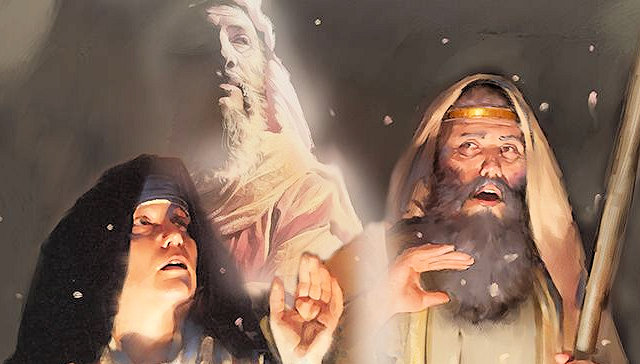

1. Can it be believed he was raised by God to talk with Saul, when God clearly forbade this abhorrent practice on capital pain of death Leviticus 19:31; 20:27; Deut. 18:12; 20:6 for necromancers, will Yahweh violate his own Law?
2. Would such a holy prophet as Samuel who held witchcraft1 as a Heinous, grievous sin 1 Samuel 15:23 first hold a private conversation with this wicked woman in her incantations to warn her about king Saul so she screams in startled terror?
3. Had Saul been really raised Saul would have seen him as well as the woman. That Saul could not see him is convincing proof that Saul was not raised from the dead. He must have been raised by only two powers either holy Yahweh or devils. It is certain righteous Yahweh would not raise his servant to answer to evil sorcery. The witch tells Saul, “I see elohim2 or ‘angels’ coming up from the earth” (v.13; cf. Isa. 8:19) Saul had asked Yahweh to speak to him by 1. dreams, by the 2. Urim ve-Tummim, or through 3. prophets but for his wickedness had been refused. Are we to believe Yahweh changes his mind by no repentance? This time he sins and asks familiar spirits or the fallen angels and they readily respond arranging a convincing impersonation3.
4. If it really was holy Samuel the prophet he would have been raised in glory and come from heaven not raised from the earth at night as an “old man wrapped in a cloak” I Sam. 28:14
5. He was buried and asleep in Ramah which refuted the rabbis claim that the spirit remains near the grave so how could he have been raised from the ground at Endor?
6. The message from this spirit says;
a. The Lord is departed from thee and is your enemy; ie; there is no hope
b. The Lord has rent the Kingdom from you to give to your neighbor, to David. This thrust at his anguish and weakness.
c. You ruin is sure by your sins in the expedition of Amalek.
d. Your “army shall suffer terrible defeat, your sons and you shall be slain.”
Saul buys this litany of doom completely, hook line and sinker. They play on his three main Fears. 1. He fears David (18:12, 15, 29), 2. he is afraid of the Philistines (28:5), and 3. he is afraid of his own death (28:20) The army of Israel is defeated by the philistines as predicted, his sons are killed, so far the spirit ‘predictions’ are true, yet there is a major fault in the “prophecy.”
Saul was not slain in battle but wounded. Yahweh alone knows the future while the devils or satan can only guess and approximate. The fact this was not from Yahweh is clear in that the spirit says a prophetic lie. “Samuel” tells Saul: When I was in the world of falsehood, I feared that you would kill me, so I spoke falsely to you. Now that I am in the world of truth, I am not in awe of you, and so you hear the truth from me.” Here we have an approximation or a prophetic lie, Saul was Not slain.
With hope gone, believing the merciless lie of “you …be slain”, Saul fell upon his sword a death of suicide, another grievous sin. Satan or spirits can only guess and approximate. The rampant spiritism of today owes its tragic “success” to just such shrewd cunning, deceptive perfect approximations.
Thank you for your comments. Your opinions and the details you supply should prove helpful for others who wish to analyze this event.
My pastor says the spirit that Saul saw was God because His name is Elohim.
Thank you for visiting this site and for leaving a comment, however . . .
Elohim is used over 2500 times in the Hebrew Bible. Although it does sometimes refer to God Almighty, it also refers to others, too. And Elohim can be singular or plural in nature.
As biblical scholar Michael Heiser said, Elohim “…as a term describes residence — it identifies the proper domain of the entity described by it. Yahweh, the lesser gods, angels, demons, and the disembodied dead are all rightful inhabitants of the spiritual world.”
This spiritual world, like our human world, has creatures of different rank and power. For more about this subject, see the article titled “Why did God say: “Let US make man in OUR image, after OUR likeness?”
https://outlawbiblestudent.org/why-did-god-say-let-us-make-man-in-our-image-after-our-likeness/
Hey Ray, thanks for linking to our video and I appreciate the in-depth look into this. Love how you gave cultural context to the witch and I learned a lot from reading what you wrote.
Thank you for the kind words. And thank you, too, for the fine work you guys are doing in our Lord’s work.